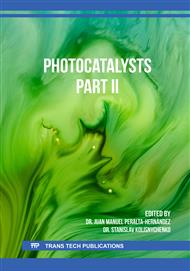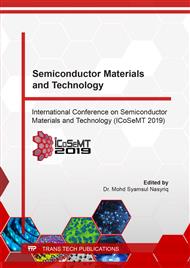[1]
Fagan, R., McCormack, D. E., Dionysiou, D. D., & Pillai, S. C. A review of solar and visible light active TiO2 photocatalysis for treating bacteria, cyanotoxins and contaminants of emerging concern. Materials Science in Semiconductor Processing. 42 (2016) 2-14.
DOI: 10.1016/j.mssp.2015.07.052
Google Scholar
[2]
Cesaro, A., & Belgiorno, V. Removal of endocrine disruptors from urban wastewater by advanced oxidation processes (AOPs): a review. The Open Biotechnology Journal. 10 (2016) 1-7.
DOI: 10.2174/1874070701610010151
Google Scholar
[3]
Kumar, E., & Holt, W. V. Impacts of endocrine disrupting chemicals on reproduction in wildlife. In W. V. Holt, J. L. Brown & P. Comizzoli (Eds.), Reproductive Sciences in Animal Conservation: Progress and Prospects, Springer New York, New York 2014 (pp.55-70).
DOI: 10.1007/978-1-4939-0820-2_4
Google Scholar
[4]
Hughes, J. S., & Trafimow, D. Inferences about character and motive influence intentionality attributions about side effects. British Journal of Social Psychology. 51 (2012) 661-673.
DOI: 10.1111/j.2044-8309.2011.02031.x
Google Scholar
[5]
Petrie, B., Barden, R., & Kasprzyk-Hordern, B. A review on emerging contaminants in wastewaters and the environment: Current knowledge, understudied areas and recommendations for future monitoring. Water Research. 72 (2015) 3-27.
DOI: 10.1016/j.watres.2014.08.053
Google Scholar
[6]
Mohamed, E. F. Removal of organic compounds from water by adsorption and photocatalytic oxidation. Ph.D. Thesis. Université de Toulouse, France. (2011).
Google Scholar
[7]
Anbia, M., and Ghaffari, A. Adsorption of phenolic compounds from aqueous solutions using carbon nanoporous adsorbent coated with polymer. Applied Surface Science. 255 (2009) 9487-9492.
DOI: 10.1016/j.apsusc.2009.07.070
Google Scholar
[8]
Michałowicz, J., and Duda, W. Phenols--Sources and Toxicity. Polish Journal of Environmental Studies. 16 (2007) 347-362.
Google Scholar
[9]
Cassabois, G., Valvin, P., and Gil, B. Hexagonal boron nitride is an indirect bandgap semiconductor. Nature Photonics. 10 (2016) 262–266.
DOI: 10.1038/nphoton.2015.277
Google Scholar
[10]
Zain, M., Kanti, P., & Sabir, S. Bioremediation of 2-chlorophenol containing wastewater by aerobic granules-kinetics and toxicity. Journal of Hazardous Materials. 190 (2011) 222–228.
DOI: 10.1016/j.jhazmat.2011.03.029
Google Scholar
[11]
Ahmed, S., Rasul, M. G., Brown, R., and Hashib, M. A. Influence of parameters on the heterogeneous photocatalytic degradation of pesticides and phenolic contaminants in wastewater: A short review. Journal of Environmental Management. 92 (2011) 311–330.
DOI: 10.1016/j.jenvman.2010.08.028
Google Scholar
[12]
Byrne, C., Subramanian, G., & Pillai, S. C. Recent advances in photocatalysis for environmental applications. Journal of Environmental Chemical Engineering. 6 (2018) 3531-3555.
DOI: 10.1016/j.jece.2017.07.080
Google Scholar
[13]
Raghavan, N., Thangavel, S., and Venugopal, G. Enhanced photocatalytic degradation of methylene blue by reduced graphene-oxide/titanium dioxide/zinc oxide ternary nanocomposites. Materials Science in Semiconductor Processing. 30 (2015) 321–329.
DOI: 10.1016/j.mssp.2014.09.019
Google Scholar
[14]
Raliya, R., Avery, C., Chakrabarti, S., and Biswas, P. Photocatalytic degradation of methyl orange dye by pristine titanium dioxide, zinc oxide, and graphene oxide nanostructures and their composites under visible light irradiation. Applied Nanoscience. 7 (2017) 253–259.
DOI: 10.1007/s13204-017-0565-z
Google Scholar
[15]
Shahabuddin, S., Khanam, R., Khalid, M., Sarih, N. M., Ching, J. J., Mohamad, S., & Saidur, R. Synthesis of 2D boron nitride doped polyaniline hybrid nanocomposites for photocatalytic degradation of carcinogenic dyes from aqueous solution. Arabian Journal Of Chemistry. 11 (2018) 1000-1016.
DOI: 10.1016/j.arabjc.2018.05.004
Google Scholar
[16]
Sabarinathan, M., Harish, S., Archana, J., Navaneethan, M., Ikeda, H., and Hayakawa, Y. Highly efficient visible-light photocatalytic activity of MoS2–TiO2 mixtures hybrid photocatalyst and functional properties. RSC Advances. 7 (2017). 24754-24763.
DOI: 10.1039/c7ra03633g
Google Scholar
[17]
Nguyen, D. N., and Yoon, H. Recent advances in nanostructured conducting polymers: From synthesis to practical applications. Polymers 8 (2016) 118.
DOI: 10.3390/polym8040118
Google Scholar
[18]
Sani, N. A. N. M., Mazlan, N. A., Mohamed, A. H., Sambasevam, K. P., Jantan, K. A., Ramachandran, M. R., & Sapari, J. M. Removal of 2, 4-dinitrophenol (2, 4-DNP) by using magnetic nanoparticles (MNPs) coated with polypyrrole (PPy). In IOP Conference Series: Materials Science and Engineering. 458 (2018) 12007.
DOI: 10.1088/1757-899x/458/1/012007
Google Scholar
[19]
Rashid, S., Mazlan, N. A., Sapari, J. M., Ramachandran, M. R., & Sambasevam, K. P. Fabrication of magnetic nanoparticles coated with polyaniline for removal of 2, 4-dinitrophenol. In Journal of Physics: Conference Series.1123 (2018) 12015.
DOI: 10.1088/1742-6596/1123/1/012015
Google Scholar
[20]
Humpolíček, P., Kašpárková, V., Pacherník, J., Stejskal, J., Bober, P., Capáková, Z., ... & Lehocký, M. The biocompatibility of polyaniline and polypyrrole: A comparative study of their cytotoxicity, embryotoxicity and impurity profile. Materials Science and Engineering: C. 91 (2018) 303-310.
DOI: 10.1016/j.msec.2018.05.037
Google Scholar
[21]
Appavu, B., Kannan, K., and Thiripuranthagan, S. Enhanced visible light photocatalytic activities of template free mesoporous nitrogen doped reduced graphene oxide/titania composite catalysts. Journal of Industrial and Engineering Chemistry. 36 (2016) 184-193.
DOI: 10.1016/j.jiec.2016.01.042
Google Scholar
[22]
Pasternak, S., & Paz, Y. On the similarity and dissimilarity between photocatalytic water splitting and photocatalytic degradation of pollutants. ChemPhysChem. 14 (2013) 2059-2070.
DOI: 10.1002/cphc.201300247
Google Scholar
[23]
Ibrahim, H. M. M. Photocatalytic degradation of methylene blue and inactivation of pathogenic bacteria using silver nanoparticles modified titanium dioxide thin films. World Journal of Microbiology and Biotechnology, 31 (2015) 1049–1060.
DOI: 10.1007/s11274-015-1855-9
Google Scholar
[24]
Sultan, A., Ahmad, S., Anwer, T., and Mohammad, F. Binary doped polypyrrole and polypyrrole/boron nitride nanocomposites: preparation, characterization and application in detection of liquefied petroleum gas leaks. RSC Advances. 5 (2015) 105980-105991.
DOI: 10.1039/c5ra21173e
Google Scholar
[25]
Yang, X., Zhang, L., Chen, Z., Jing, H., Chen, Y., and Li, Q. Synthesis of magnetic photocatalyst and sensitization properties of polypyrrole. Science and Engineering of Composite Materials. 23 (2016) 269–275.
DOI: 10.1515/secm-2014-0035
Google Scholar
[26]
Singh, T., Srivastava, N., Mishra, P. K., Bhatiya, A. K., & Singh, N. L. Application of TiO2 nanoparticle in photocatalytic degradation of organic pollutants. Materials Science Forum. 855 (2016) 20-32.
DOI: 10.4028/www.scientific.net/msf.855.20
Google Scholar



